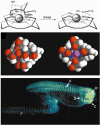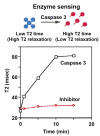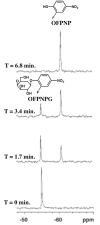Detecting enzyme activities with exogenous MRI contrast agents
- PMID: 24990812
- PMCID: PMC4117811
- DOI: 10.1002/chem.201402474
Detecting enzyme activities with exogenous MRI contrast agents
Abstract
This review focuses on exogenous magnetic resonance imaging (MRI) contrast agents that are responsive to enzyme activity. Enzymes can catalyze a change in water access, rotational tumbling time, the proximity of a (19)F-labeled ligand, the aggregation state, the proton chemical-exchange rate between the agent and water, or the chemical shift of (19)F, (31)P, (13)C or a labile (1)H of an agent, all of which can be used to detect enzyme activity. The variety of agents attests to the creativity in developing enzyme-responsive MRI contrast agents.
Keywords: CEST MRI; MR spectroscopy; enzymes; imaging agents; relaxation-based MRI.
© 2014 WILEY-VCH Verlag GmbH & Co. KGaA, Weinheim.
Figures





Similar articles
-
A review of responsive MRI contrast agents: 2005-2014.Contrast Media Mol Imaging. 2015 Jul-Aug;10(4):245-65. doi: 10.1002/cmmi.1629. Epub 2014 Oct 29. Contrast Media Mol Imaging. 2015. PMID: 25355685 Free PMC article. Review.
-
An overview of responsive MRI contrast agents for molecular imaging.Front Biosci. 2008 Jan 1;13:1733-52. doi: 10.2741/2796. Front Biosci. 2008. PMID: 17981664 Review.
-
Using two chemical exchange saturation transfer magnetic resonance imaging contrast agents for molecular imaging studies.Acc Chem Res. 2009 Jul 21;42(7):915-24. doi: 10.1021/ar8002738. Acc Chem Res. 2009. PMID: 19514717 Free PMC article.
-
Ytterbium chelated to 1,4,7,10-tetraazacyclododecane-1,4,7-triacetic acid,10-orthoaminoanilide.2011 Nov 26 [updated 2012 Jan 5]. In: Molecular Imaging and Contrast Agent Database (MICAD) [Internet]. Bethesda (MD): National Center for Biotechnology Information (US); 2004–2013. 2011 Nov 26 [updated 2012 Jan 5]. In: Molecular Imaging and Contrast Agent Database (MICAD) [Internet]. Bethesda (MD): National Center for Biotechnology Information (US); 2004–2013. PMID: 22238803 Free Books & Documents. Review.
-
A self-calibrating PARACEST MRI contrast agent that detects esterase enzyme activity.Contrast Media Mol Imaging. 2011 Jul-Aug;6(4):219-28. doi: 10.1002/cmmi.421. Epub 2010 Nov 30. Contrast Media Mol Imaging. 2011. PMID: 21861282 Free PMC article.
Cited by
-
Methods of Measuring Enzyme Activity Ex Vivo and In Vivo.Annu Rev Anal Chem (Palo Alto Calif). 2018 Jun 12;11(1):509-533. doi: 10.1146/annurev-anchem-061417-125619. Epub 2018 Mar 5. Annu Rev Anal Chem (Palo Alto Calif). 2018. PMID: 29505726 Free PMC article. Review.
-
Electroosmotic Perfusion-Microdialysis Probe Created by Direct Laser Writing for Quantitative Assessment of Leucine Enkephalin Hydrolysis by Insulin-Regulated Aminopeptidase in Vivo.Anal Chem. 2020 Nov 3;92(21):14558-14567. doi: 10.1021/acs.analchem.0c02799. Epub 2020 Oct 12. Anal Chem. 2020. PMID: 32961052 Free PMC article.
-
Chemistry of MRI Contrast Agents: Current Challenges and New Frontiers.Chem Rev. 2019 Jan 23;119(2):957-1057. doi: 10.1021/acs.chemrev.8b00363. Epub 2018 Oct 16. Chem Rev. 2019. PMID: 30350585 Free PMC article. Review.
-
Arginase as a Potential Biomarker of Disease Progression: A Molecular Imaging Perspective.Int J Mol Sci. 2020 Jul 25;21(15):5291. doi: 10.3390/ijms21155291. Int J Mol Sci. 2020. PMID: 32722521 Free PMC article. Review.
-
RGD-Peptide Functionalization Affects the In Vivo Diffusion of a Responsive Trimeric MRI Contrast Agent through Interactions with Integrins.J Med Chem. 2021 Jun 10;64(11):7565-7574. doi: 10.1021/acs.jmedchem.1c00264. Epub 2021 May 7. J Med Chem. 2021. PMID: 33961422 Free PMC article.
References
-
- Sittampalam GS. Assay Guidance Manual. Eli Lilly & Company and the National Center for Advancing Translational Sciences; Bethesda MD: 2004. - PubMed
-
- Messerschmidt A, editor. Handbook of Metalloproteases. 2011.
- Adam JA. Chem. Rev. 2001,;101:2271–2290. - PubMed
- Barrett AJ, Rawlings ND, Woessner JF, editors. Handbook of Proteolytic Enzymes. Academic Press; London: 1998.
-
- Gatti-Lafranconi P, Hollfelder F. ChemBioChem. 2013;14:285–292. - PubMed
-
- Moffitt JR, Chemla YR, Bustamante C. Methods in Enzymology (Single Molecule Tools, Part B) 2010:221–257. - PubMed
-
- Maeng HJ, Chow ECY, Fan J, Pang KS. In: Encyclopedia of Drug Metabolism and Interactions. Lyubimov AV, Rodrigues AD, Sinz MA, editors. 2012. pp. 637–684.
Publication types
MeSH terms
Substances
Grants and funding
LinkOut - more resources
Full Text Sources
Other Literature Sources
Medical

